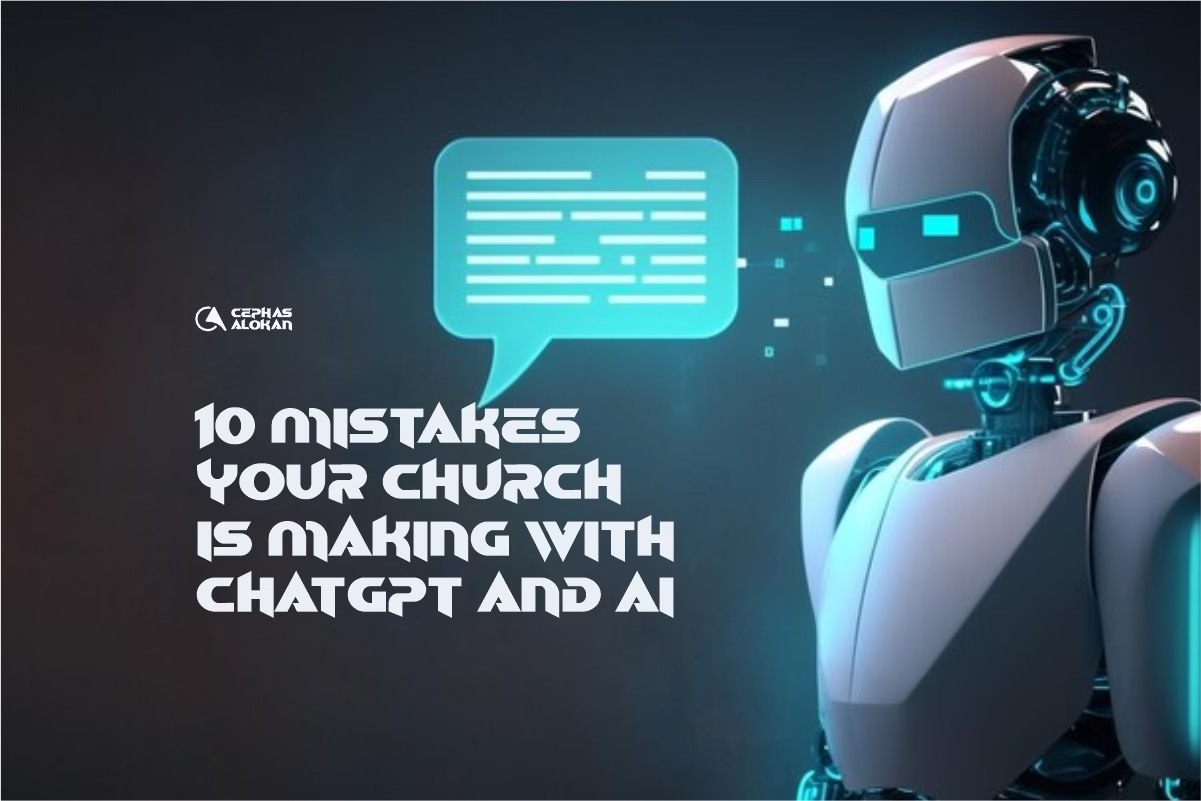The Church is standing at a digital crossroads, with Artificial Intelligence (AI) now occupying the minds of pastors, ministers, editorial teams, media units, administrators, and even choirs, all looking for ways to simplify their work.
I’ve seen conversations online about the use of generative AI tools like ChatGPT for sermon preparation. Some people, especially from more traditional or orthodox backgrounds, believe it’s an abomination to rely on such tools for sacred duties.
But the right response is not to fight or flee from AI, it’s to understand it. Just like a Bible concordance or even Google, AI is a tool. The difference is that it’s more advanced and must be handled with greater discernment.
This post isn’t focused on whether or not to use AI. Instead, I want to address the mistakes some pastors and churches are already making in their use of generative AI, many of them unknowingly.
As kingdom leaders, we are called to lead with wisdom, not blindly follow trends. We must steward AI with spiritual intelligence and not cultural impulse.
There are certainly more than ten mistakes out there, but I’ll highlight the top 10 common ones I’ve observed. If you’ve noticed others, feel free to share in the comment section.
1. Using AI Without Theological Discernment
One of the biggest mistakes churches make is using AI without applying biblical or doctrinal filters. AI tools can quickly generate sermon outlines, devotionals, or prayer points, but the content may be shallow, misaligned with scripture, divine leading, or even subtly misleading.
AI isn’t filled with the Holy Spirit. It draws from data, not divine revelation.
How to fix it: Use AI as a support tool, not a source of truth. Cross-check everything with Scripture, and train your team to discern truth from well-packaged error.
2. Assuming AI Is Spiritually Neutral
It’s easy to think of AI as just a tool. But every AI model is trained on human-created data, and that data often reflects secular worldviews. If churches don’t evaluate the outputs through a biblical lens, they may unknowingly spread ideologies that contradict the Gospel.
For instance, AI might generate gender-neutral God language, promote worldly definitions of success, or overlook spiritual nuances entirely.
How to fix it: Teach your media and content teams to review AI-generated outputs with biblical filters. Stay alert to embedded ideologies and subtly distorted truths.
3. Introducing AI Tools Without Training
Churches often roll out new tech tools without first educating staff or volunteers. If no one’s trained, mistakes multiply: wrong content gets published, data is shared irresponsibly, and AI tools are either underused or misused.
How to fix it: Before introducing any AI platform for content creation, communication, or planning, offer a workshop or onboarding session. Equip your team to use AI effectively and responsibly.
4. Replacing Spirit-Led Ministry with AI Automation
AI can generate prayers, reply to messages, and even simulate counseling, but it can’t carry the burden of spiritual discernment or compassionate ministry. Over-relying on AI may cause your church to feel impersonal or disconnected.
How to fix it: Use AI to assist, not replace, human-led ministry. Let it free up time for deeper, relational, Spirit-filled engagement rather than serving as a substitute for it.
5. Operating Without an AI Policy
Many churches are using AI tools without any formal policy to guide its use. Without clear boundaries, team members may:
- Use tools that compromise doctrinal integrity
- Share confidential information
- Create inconsistent content across departments
How to fix it: Draft an official Church AI Usage Policy. Outline acceptable tools, privacy standards, content boundaries, and theological oversight. Update it regularly as technology evolves.
6. Uploading Sensitive Data to Public AI Tools
It’s easy to paste a sermon draft, prayer request, or event plan into ChatGPT or another AI tool without realizing: you might be sharing private or proprietary information.
Most free AI tools store, learn from, or use user inputs to improve their models. This could unintentionally leak sensitive church data.
How to fix it: Never input sensitive or confidential data into public AI platforms. Use privacy-protected or self-hosted solutions where necessary and educate your team about the risks.
7. Chasing Trends Over Truth
AI can quickly generate trendy content that performs well on social media. But when churches prioritize virality like funny quotes, trending soundbites, or pop-culture catchphrases over sound doctrine, they can lose their prophetic voice.
How to fix it: Use AI to amplify truth, not dilute it. Let your content be engaging, but rooted in biblical clarity and eternal value.
8. Overautomating Communication
Automated emails, AI replies to DMs, and auto-generated sermon notes can save time. But when everything feels robotic, people feel unseen. Church is about people, not just processes.
How to fix it: Maintain a human voice. Blend AI efficiency with real pastoral care, especially in responses to prayer requests, counseling, or member follow-up.
9. Neglecting Discipleship on AI Ethics
AI isn’t just a tool for church leaders—your congregation is also using it. Teens are using it for homework, creatives are using it for design, and professionals are using it at work. If the Church doesn’t disciple people in how to use AI wisely, the world will.
How to fix it: Teach sermons, workshops, or small group sessions on biblical ethics for AI. Raise digital ministers who use technology for God’s glory, not just convenience.
10. Failing to Think Generationally About AI
AI will outlive your current team. The way your church uses AI today is laying the foundation for how future leaders, staff, and congregants will engage with technology—and possibly truth.
How to fix it: Lead with a multi-generational vision. Document decisions. Train young leaders to steward AI responsibly and ensure it becomes a tool for kingdom advancement, not compromise.
AI Is a Tool, But the Spirit Is the Guide
Artificial Intelligence is a powerful gift when stewarded rightly. But without vision, strategy, and spiritual discernment, it can become a trap.
Churches must lead the conversation, not follow it.
Don’t wait until a crisis or controversy exposes AI misuse. Start now:
- Create a policy.
- Train your teams.
- Guard your message.
- Equip your people.
Tell me how you have been using AI in your church






